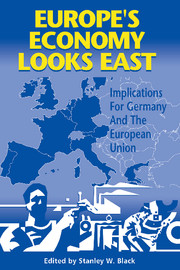Book contents
- Frontmatter
- Contents
- List of figures and tables
- Preface
- List of conference participants
- List of acronyms
- 1 Introduction
- I Trade relations
- II Investment patterns
- III Labor market issues
- IV The process of integration
- 8 Joining the club: options for integrating Central and Eastern European Countries into the European Union
- Comments
- Index
8 - Joining the club: options for integrating Central and Eastern European Countries into the European Union
Published online by Cambridge University Press: 03 February 2010
- Frontmatter
- Contents
- List of figures and tables
- Preface
- List of conference participants
- List of acronyms
- 1 Introduction
- I Trade relations
- II Investment patterns
- III Labor market issues
- IV The process of integration
- 8 Joining the club: options for integrating Central and Eastern European Countries into the European Union
- Comments
- Index
Summary
Transformation and integration
The transformation from plan to market puts a heavy burden on the countries in Central and Eastern Europe. Most of this burden these countries will have to carry on their own as Western support will be limited. Aside from technical and some financial aid, the most important support the European Union can offer is access to its markets and particularly access to its economic and political integration, that is, full EU membership. The Visegrad countries unequivocally expresses their desire to join the Union at the turn of the millennium: Poland and Hungary submitted their applications in 1994, Slovakia followed in 1995, the Czech Republic in January 1996. Although practical integration is already taking place, the EU is still undecided on the route to integration, preconditions, and a timetable for accession, or as Baldwin (1994, p. xv) put it: “Pan-European integration is proceeding, but no one seems to be in charge.”
At a very early stage of the transformation process, in September 1989, a then very popular policy proposal (Kostrzewa and Schmieding, 1989) was for the Eastern European countries to join the EFTA. This was intended to create a large free trade area without making the reform states part of the Western European ambitions of building a political union. In 1995, this integration strategy is no longer a major option as most EFTA countries have either merged with the European Union or converged to the European Economic Area (EEA) with much closer ties with the EU.
- Type
- Chapter
- Information
- Europe's Economy Looks EastImplications for Germany and the European Union, pp. 315 - 341Publisher: Cambridge University PressPrint publication year: 1997



